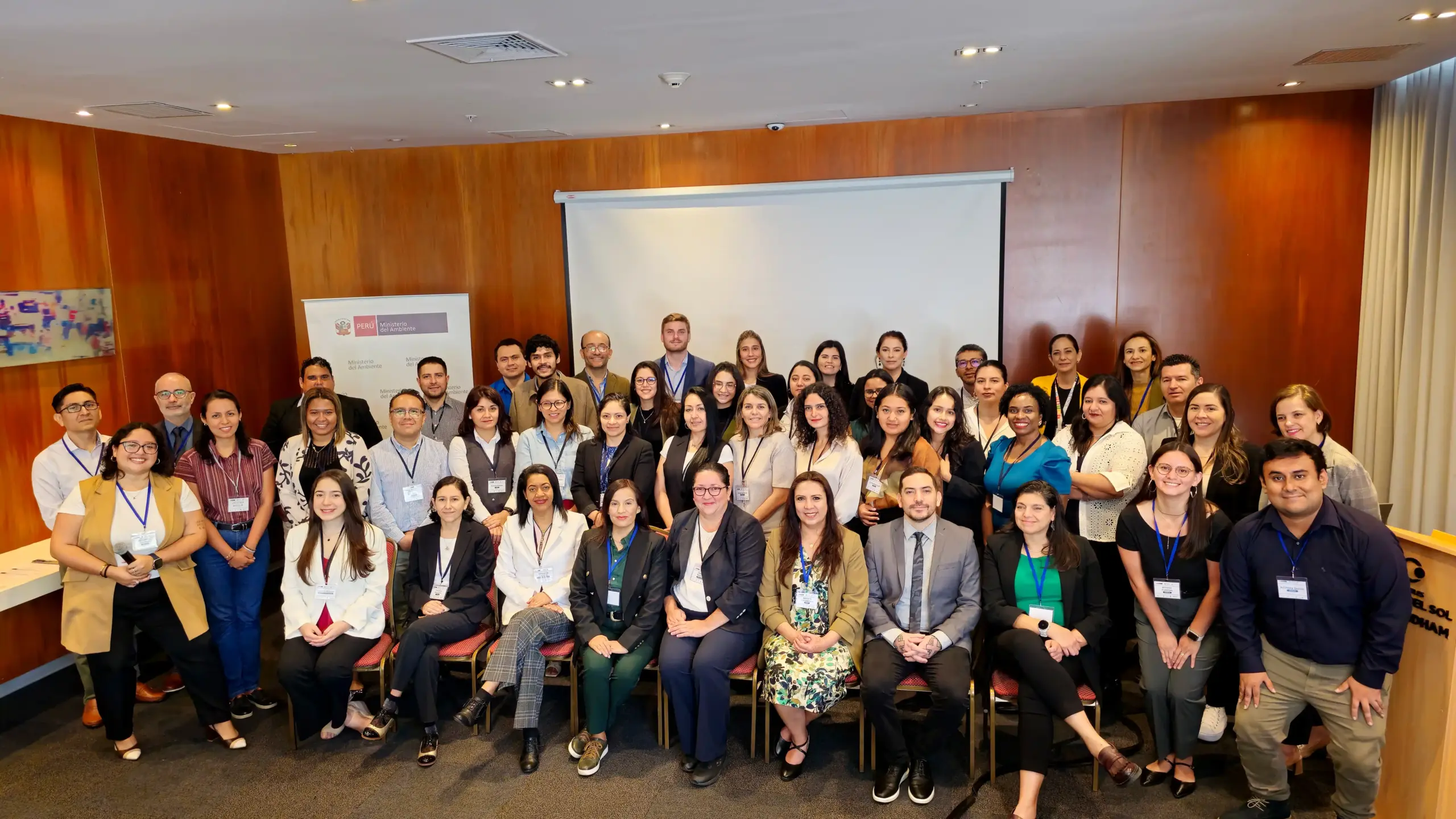Latin america strengthens its climate action with key learnings on transparency

Representatives from more than 15 countries in the region shared progress and challenges in the elaboration of their transparency reports (BTR) and their new commitments (NDC 3.0) under the Paris Agreement, outlining a common roadmap towards greater transparency and climate ambition.
Lima, April 2025. At the beginning of April, in Lima, Peru, authorities and representatives from 15 countries in the region focused on climate action met at a technical training organized by the Partnership for Transparency in the Paris Agreement (PATPA), the Capacity Building for Transparency Initiative - Global Support Program (CBIT-GSP) and the Peruvian Ministry of Environment, with the support of Libélula.
During three intensive days, participants strengthened their capacities to address progress and challenges on the road to updating the NDC 3.0 and implementing improvements to submit their second Biennial Transparency Report (BTR).
Cooperation: a boost for transparency
Currently 101 countries have submitted their first BTR, of which 19 belong to Latin America and the Caribbean, which signifies an important leadership and progress for the region. In addition, 68 countries have developed their NDCs; and the world's leading economies - which together account for 87% of global GDP - have committed to achieving greenhouse gas emissions neutrality in the coming decades.
Against this backdrop, Tim Bantel, PATPA coordinator for Latin America and the Caribbean, explained that cooperation between countries is more than an exchange of best practices: it is a key tool to accelerate the implementation of climate transparency in the region.. "The meeting has shown that continuous improvement under the Enhanced Transparency Framework (ETF) is not a distant ideal, but an achievable reality if we work together, sharing what works. Climate action requires articulation, and strengthened capacities." said Bantel.
The creation of communities of practice and spaces such as those promoted by PATPA and CBIT-GSP have been fundamental for South-South cooperation. It was recognized that sharing experiences and tools among countries has allowed for faster progress, learning from common mistakes and building more robust reporting systems.
Lisandra Rodriguez, of the Dominican Republic's Metrics and Transparency Department, noted that one of their main challenges is to work simultaneously on the LTS, NDC 3.0 and the first BTR, with little time, scarce staff and changes in government. "We have learned at this workshop from the experiences of each of the countries that have already reported to the Convention and have been reviewed."he said.
Leonardo Pineda, coordinator of the Global Change Group of Colombia's Ideam, stressed that his country is moving forward in a participatory process to update its 2030 goals and move towards decarbonization by 2050. He stressed that the exchange in Lima strengthened regional cooperation and provided key inputs to improve indicators, integrate projections and give greater relevance to adaptation.
Latin America moves towards NDC 3.0
In addition to the challenge of complying with ETF requirements, countries face an additional challenge: updating their NDCs. The training highlighted the importance of aligning these two processes to achieve more ambitious and coherent climate progress.
During the sessions, representatives reviewed the progress of the first BTR, delved into the Technical Expert Review (TER), and explored how NDC 3.0 can be aligned to it and to the results of the first Global Stocktaking (GST1), incorporating concrete improvements and more ambitious targets.
The NDCs 3.0, due in 2025, represent an opportunity to raise climate ambition, and connect short- and long-term planning, aligning adaptation and mitigation goals.
One of the main lessons learned from the training was the need to strengthen national capacities not only to ensure the quality, transparency and traceability of reported climate information, but also to implement commitments effectively. Countries such as Uruguay, Mexico and Peru shared their remarkable progress in integrating mitigation and adaptation measures through sound regulatory frameworks, monitoring systems and participatory governance.
Berioska Quispe, Director of Climate Change and Desertification of the Peruvian Ministry of the Environment, said that it is important for the countries of the region toThe country's climate action is working at an accelerated pace. "In these five years leading up to 2030, we also face significant challenges in Peru, but we have managed to submit our first BTR by the end of December 2024 and we are now in the process of preparing our NDC 3.0." he explained.
Results and key learning at country level
The dialogue between countries during the meeting made it possible to identify innovative approaches and common challenges, among which the following stand out:
- Uruguay has developed a visual tracking system that allows public access to mitigation and adaptation progress.
- Peru presented progress in the institutionalization of adaptation, with a National Adaptation Plan aligned with the transparency framework and the development of specific indicators.
- Dominican Republic stressed the need to simplify its indicators and expressed its openness to strengthening regional cooperation.
- VenezuelaDespite facing challenges in updating GHG inventories, the company showed an attitude of continuous improvement, identifying the need to include indicators and new sectors in its NDCs.
- Cuba identified cooperative instruments as a way to achieve the development of a low-carbon economy, and is exploring the innovative field of blue carbon.
- Mexico stressed the importance of having clear methodologies in projections and a coherent legal framework between climate plans and reports.
Carbon markets and climate ambition
A key session of the workshop was the discussion around Article 6 of the Paris Agreement, referring to carbon market mechanisms, and its implementation in the region. Countries such as Cuba, Brazil, Ecuador and Uruguay have already included their intention to use this item in their NDCs, whereas Peru has made progress in regulatory and technical preparation.
Participation in carbon markets was discussed as an alternative to increase climate ambition, provided that principles of environmental integrity and long-term sustainable benefits are respected. The challenge: to design transformative projects that contribute to meeting national goals without compromising local development.
Roadmap for greater climate transparency
Effective implementation of the Paris Agreement depends on two fundamental pillars: ambitious climate action and the transparency that underpins it. Measuring, monitoring and reporting progress are not isolated processes; they are drivers that strengthen planning, decision-making and the credibility of national commitments. Without a robust transparency framework, implementation efforts would remain fragmented and difficult to scale.
In this context, countries are advancing on a roadmap that articulates the strengthening of climate transparency with the progressive improvement of their Nationally Determined Contributions (NDCs). This roadmap not only improves the quality of the information reported, but also drives effective climate action in the short and long term, ensuring that the commitments made translate into tangible results.
The main actions that make up this process towards greater ambition, coherence and effectiveness in climate policies are described below:
- Development of the first BTR (BTR1):
The countries presented their first Biennial Transparency Reports, which provided important lessons learned about national challenges and capacities. - Commencement of the Technical Expert Review (TER):
Ongoing process that analyzes the BTR1 and provides recommendations to improve the quality, transparency and traceability of the information reported. - Integration of BTR and NDC to the Global Balance Sheet (GST):
Inputs from BTR1 and NDC 3.0 feed into the Global Stocktake, helping to assess collective progress towards the Paris Agreement targets. - Preparation of the second BTR (BTR2):
With the lessons learned and technical recommendations, the countries should prepare a second report that is more robust and aligned with transparency standards. - NDC 3.0 update:
In parallel, work is being done to update the Nationally Determined Contributions, incorporating more ambitious goals and new areas (mitigation, adaptation, markets, etc.). Importantly, BTRs are key to this process and GST should guide NDC 3.0. - Needs analysis:
Based on the NDC 3.0 and the reporting process, countries identify technical, financial and institutional gaps and needs. - Identification of areas for improvement in the BTRs:
These represent concrete opportunities to strengthen climate action and improve future reporting. - Development of an Improvement Plan:
Based on all the previous stages, a roadmap is constructed to guide the development of the BTR2 and other reports required by the Convention.
The Training on the interconnection between NDC 3.0, BTRs and progressive enhancement under the ETF left a strong conclusion: progress in climate transparency is possible and necessary. To achieve this, countries must strengthen their technical capacities, consolidate solid regulatory frameworks and commit to participatory processes that link all sectors. The road to NDC 3.0 is already mapped out, and the region is moving forward with determination, with shared lessons learned, clear challenges and a renewed conviction that climate action is only effective when it is built collaboratively and based on evidence.
← Previous
Next →
Stay up to date
Receive a summary of the most relevant news about companies and sustainability. Every month, free of charge!


